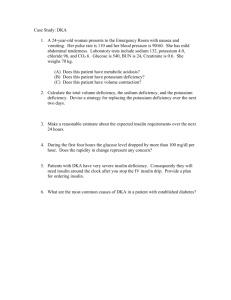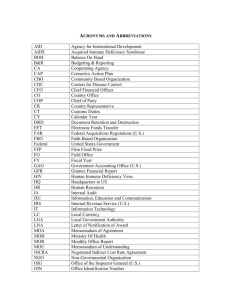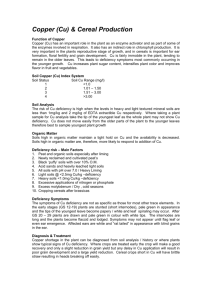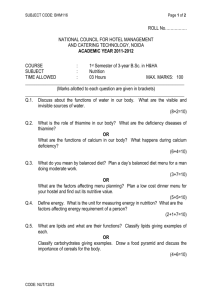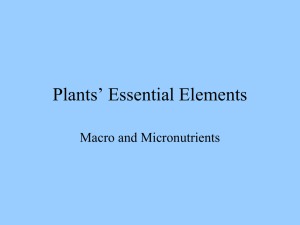Nutrient Deficiencies and Application Injuries in Field Crops INTEGRATED PEST MANAGEMENT
advertisement
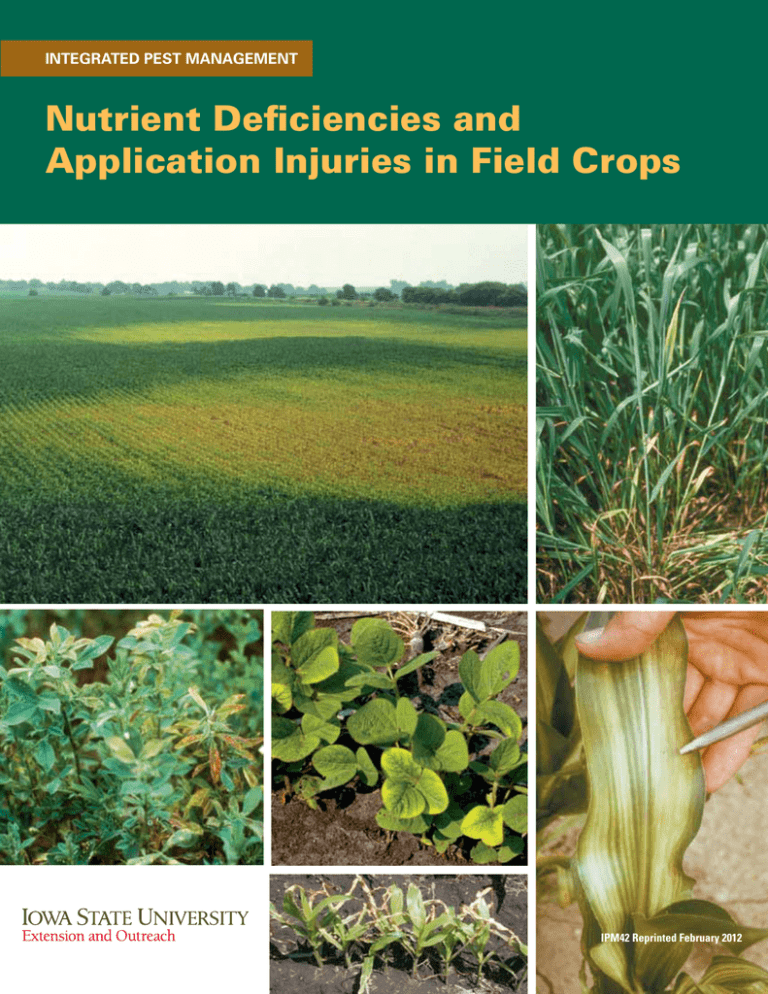
INTEGRATED PEST MANAGEMENT Nutrient Deficiencies and Application Injuries in Field Crops IPM42 Reprinted February 2012 Nutrient Deficiencies Corn Nitrogen deficiency Nitrogen (N) Nitrogen deficiency causes pale, yellowish-green corn plants with spindly stalks. Because nitrogen is a mobile nutrient in the plant, symptoms begin on the older, lower leaves and progress up the plant if the deficiency persists. Symptoms appear on leaves as a v-shaped yellowing, starting at the tip and progressing down the midrib toward the leaf base. The condition is favored by cold or saturated soil; dry soil, particularly after mid-season; large amounts of low-nitrogen residue; sandy soil; inadequate fertilization; leaching from heavy rainfall; and flooded or ponded soil when the temperature is warm. Phosphorus (P) Phosphorus deficiency is usually visible on young corn plants. It readily mobilizes and translocates in the plant. Plants are dark green with reddish-purplish leaf tips and margins on older leaves. Newly emerging leaves will not show the coloration. Phosphorus-deficient plants are smaller and grow more slowly than do plants with adequate phosphorus. Deficiency symptoms nearly always disappear when plants grow to three feet or taller. Some corn hybrids tend to show purple colors at early stages of growth even though phosphorus nutrition is adequate, yet other hybrids do not show the color symptoms even though inadequate phosphorus severely limits yields. Phosphorus deficiency is favored by cold soils that are too wet or too dry; phosphorus applied where plant roots cannot absorb it; restricted root growth in compacted soils; and roots injured by insects, herbicides, fertilizers, or cultivation. Phosphorus deficiency Potassium (K) Potassium deficiency is first seen as a yellowing and necrosis of the corn leaf margins, beginning on the lower leaves. Symptoms usually don’t appear for some time after planting (about 4 to 6 weeks, around the V6 growth stage). If the deficiency persists, symptoms progress up the plant because potassium is mobile in the plant and translocates from old to young leaves. When potassium deficiency is severe, older leaves turn yellow with tissue necrosis along the margins, but the upper new leaves may remain green. Potassium-deficient corn tends to lodge late in the growing season due to poor stalk strength. Potassium deficiency is favored by conditions that limit early root growth, development, and activity – root pruning, dry soil, compacted soil, seed trench side-wall smearing; wet soil; sandy soil; organic soil; strongly geologically-weathered soils; potassium applied where plant roots cannot absorb it; large amounts of potassium removed by a preceding crop; and some tillage systems such as ridgetillage and no-tillage, especially in a dry year and on soil with low levels of subsoil potassium. Potassium deficiency Phosphorus deficiency Phosphorus deficiency Nutrient Deficiencies Corn (CONTINUED) Sulfur deficiency Sulfur (S) Sulfur deficiency shows on small corn plants as a general yellowing of the foliage, similar to nitrogen deficiency. Yellowing of the younger upper leaves is more pronounced with sulfur deficiency than with nitrogen deficiency because sulfur is not easily translocated in the plant. Stunting of plants and delayed maturity also are symptoms. Interveinal chlorosis of the youngest leaves may occur. This deficiency is favored by acid sandy soils; low soil organic matter; and cold-dry soils in the spring that delay the release of sulfur from organic matter. Early-season symptoms may disappear as temperature and moisture conditions improve for mineralization of sulfur from organic matter, or corn roots reach plant-available sulfate contained within the soil profile. Calcium (Ca) Calcium deficiency is rare in corn. It has not been verified in Iowa. If deficient, leaf tips stick to the next lower leaf, creating a ladder-like appearance. Plants may be severely stunted because calcium is immobile in the plant; it is not translocated from old to growing plant tissue that needs calcium. Low soil pH and acid soil problems like excessive levels of soluble aluminum and manganese are more likely to occur before calcium deficiency symptoms Calcium deficiency appear. Calcium deficiency is favored by very low soil pH, below 5.0 on mineral soils and 4.8 on organic soils; nonlimed, highly weathered acid soils; or by very high magnesium and potassium and very low calcium on the cation exchange complex. Magnesium (Mg) Magnesium deficiency is first seen as yellow to white interveinal striping of the lower corn leaves. Dead, round spots sometimes follow, which give the impression of beaded streaking. Older leaves become reddish-purple, and the tips and edges may become necrotic if the deficiency is severe. This happens because magnesium is mobile in the plant and is translocated from old to new plant tissue. Magnesium deficiency is favored by very acid, sandy soils in regions of moderate to high rainfall where magnesium has been extensively leached from the soil profile. On soils marginal in crop available magnesium, deficiency can be induced by high soil potassium levels or high rates of applied potassium. Magnesium deficiency Zinc (Zn) Zinc deficiency Zinc deficiency in corn causes interveinal, light striping or a whitish band beginning at the base of the leaf and extending towards the tip. The margins of the leaf, the midrib area, and the leaf tip usually remain green. Plants are stunted because internodes are shortened. Zinc is relatively immobile in the plant. Severe zinc deficiency may result in new leaves that are nearly white, an effect termed “white bud.” Plants frequently outgrow zinc deficiency unless it is severe. Zinc deficiency is favored by high soil pH; low organic matter soils with high soil pH; cool, wet soil; and high phosphorus fertilizer applications on soils that are marginal in zinc availability, although high soil phosphorus levels alone don’t create zinc deficiency. Iron (Fe) Iron deficiency turns the interveinal area along the length of the upper leaves pale green to nearly white. It has not been verified in Iowa. Iron is immobile and is not translocated from old to young plant tissue. This deficiency is rare on corn because of its low iron requirement, and it only occurs on high pH soils. Iron deficiency is favored by calcareous soils with a high soil pH in the surface soil and by cold, wet, poorly aerated soils. Molybdenum (Mo) Molybdenum deficiency (no picture) is rarely, if ever, found in corn. It has not been identified in Iowa. If it occurs, however, older leaves become necrotic at the tip, along the margins, and between the veins. This condition is favored by very low soil pH and strongly weathered soils, conditions not normally found in the Midwest. Boron (B) Boron deficiency (no picture) is rare in corn. It has not been verified in Iowa. Leaves have small dead spots and are brittle. Boron is not readily translocated in the plant and as a result upper internodes do not elongate. Tassels and ear shoots are reduced and may not emerge. Corn is very sensitive to boron fertilizer. Boron toxicity can result if fertilizer is applied at rates above recommendations, or row applied. Deficiency is favored by drought; sandy soils that are low in organic matter; and high soil pH. Drought reduces the release of boron from organic matter, but lack of water also delays ear shoot emergence and possible pollination; therefore, symptoms may occur simultaneously and could be confused with each other. Iron deficiency Manganese (Mn) Manganese deficiency symptoms are not clear-cut. It has not been verified on corn in Iowa. Newly emerged leaves become olive-green and may become slightly streaked. If the condition is severe, deficient leaves become elongated with white streaks that turn brown in the center, deteriorate and fall out. Manganese is relatively immobile in the plant. Manganese deficiency is favored by high soil pH; sandy soils that are high in organic matter, and peat or muck soils. Manganese deficiency Copper (Cu) Copper deficiency (no picture) is rare in corn. It has not been verified in Iowa. The youngest leaves are yellow as they come out of the whorl, and the tips may die. Copper is relatively immobile in the plant. Leaves become streaked, causing an appearance that is similar to iron deficiency. The stalk is soft and limp. Some necrosis of older leaf edges occurs as it does in cases of potassium deficiency. Copper deficiency is favored by organic soils (very high soil organic matter) and by high soil pH (above 7.5). Fertilizer Injury Corn Anhydrous ammonia injury Anhydrous ammonia injury results in uneven corn seedling emergence, slow plant growth, plants with a spiked and blue-green color appearance, and wilting of seedlings in dry weather. Ammonia injury is detected more frequently in dry weather because roots are slow to develop; if a portion of the root system is destroyed, it limits water uptake. Root injury browns the roots. If severely injured, roots die and turn black back to the seed. Anhydrous ammonia Vapor (NH3) Vapor damage Anhydrous ammonia vapor damage to leaves can occur when sidedressing ammonia if the applicator knives are near or above the soil surface and there is escape of ammonia during application. Corn plants usually outgrow the damage if only a portion of the leaves is damaged. Granular Urea Granular urea Granular urea applied on top of growing corn results in some granules falling in the whorl and lodging in leaf axils. Tan to white burn spots and damaged tissue areas appear on leaves where granules lodge. Plants absorb urea through their leaves. If the amount of urea absorbed is excessive, the leaf margins turn white. Although this is a symptom of toxicity, plants outgrow the injury unless a large amount of material lodges in the whorl and the plant leaves are severely damaged or the growing point is injured. Anhydrous Ammonia Injury Non-pressure nitrogen solutions (urea-ammonium nitrate solution, 28 or 32% UAN) Non-pressure nitrogen solutions broadcast on top of growing corn can burn leaf tissue. The solutions tend to move towards the leaf tip and margins, resulting in greater burning of those leaf areas. Corn plants usually outgrow the damage if only a portion of the leaves is injured. However, leaf damage and potential yield impacts increase with higher application rates and larger plants. Urea Urea containing fertilizers when row banded with or near corn seed can result in uneven corn seedling emergence, stand loss, slow growth, and damaged roots as free ammonia is released during urea conversion to ammonium. Also, biuret in urea can cause misshapen plants or leaves that don’t unroll. Seed-placed urea stand loss and biuret damage Broadcast solution nitrogen Nutrient Deficiencies soybean Potassium deficiency Potassium (K) Potassium deficiency yellows soybean leaves, beginning at the margins and moving inward over the leaf. Deficiency symptoms occur on older lower leaves first. All but the newest emerged leaves may show potassium deficiency symptoms in severe cases. Iron deficiency Iron (fe) Iron deficiency of soybean is usually identified on young plants. Because iron is immobile in the plant, the deficiency symptoms occur on the youngest upper leaves. The leaves turn yellow, but the veins remain green. Iron deficiency occurs on high pH soils and frequently occurs on the calcareous soils of central and north central Iowa. Molybdenum (Mo) Molybdenum deficiency results in light green soybean plants. This indicates nitrogen deficiency because molybdenum is essential for the symbiotic nitrogen-fixation process. Molybdenum deficiency of soybean only occurs on very acid, highly weathered soils and has not been seen in Iowa. Molybdenum deficiency Fertilizer Injury soybean Non-pressure nitrogen solutions (urea-ammonium nitrate solution, 28 or 32% UAN) Non-pressure nitrogen solutions broadcast on top of growing soybean can burn leaf tissue. Application even at low rates can cause tissue damage. Soybean plants usually outgrow the damage if only a portion of the leaves is injured. Broadcast nitrogen solution Nutrient Deficiencies alfalfa Molybdenum deficiency Potassium deficiency Potassium (K) Potassium deficiency creates small dots on the margins of the upper leaflets of alfalfa. When severely deficient, the size and number of spots increase, the leaves become yellow and dry, and the lower leaves drop. Molybdenum (Mo) Molybdenum deficiency reduces the growth of alfalfa. Deficient plants tend to be pale or light green because molybdenum is essential for the nitrogen-fixation process. Molybdenum deficiency in alfalfa usually occurs only on very acid soils. It has not been verified in Iowa. Nutrient Deficiencies alfalfa (continued) Boron (B) Boron deficiency on alfalfa shortens the internodes near the plant top, resulting in a bunching or bushy appearance of the upper plant. The top (new) leaves turn yellow and may have a reddish purple-pink coloration on the leaflet margins. This causes the deficiency to be mistaken for leafhopper injury. Lower leaves remain green. Boron deficiency usually occurs when weather is dry and on soils that are low in organic matter. Sulfur (S) Sulfur deficiency Sulfur deficiency shows as a general yellowing of the alfalfa foliage. With severe deficiency plant growth is stunted, stems are spindly, stands appear thin, and the alfalfa is less competitive. Boron deficiency Nutrient Deficiencies winter wheat Phosphorus deficiency Phosphorus (P) Phosphorus deficiency results in reduced early plant growth and tiller development, which gives the impression of a thin stand. Plants remain green but older leaves have reddish-purplish leaf tips and margins. Newly emerging leaves do not show the coloration. Phosphorus-deficient plants are smaller and grow more slowly than do plants with adequate phosphorus. Nitrogen (N) Nitrogen deficiency appears as a general pale yellowish-green plant with slow growth and reduced tiller development. If the deficiency persists, plants remain pale green, have reduced growth, and the stand appears thin. Potassium (K) Potassium deficiency appears as a yellowing and necrosis of the leaf tip and margins, beginning on the lower leaves. If the deficiency persists, symptoms progress up the plant as potassium is mobile in the plant and translocates from old to young leaves. Nitrogen deficiency Potassium deficiency diagnosis fields Diagnosing nutrient deficiency symptoms is most reliable when all factors other than the nutrient in question favor normal growth and when the symptoms occur on several plants in an area following a specific soil or management pattern. Comparison of plants in affected and non-affected field areas, as well as other information like soil tests and cultural practices, can help determine specific causative factors. Soil Condition Nutrient deficiency symptoms that occur in irregular patterns in a field are probably due to a soil condition. Zinc deficiency in corn Iron deficiency in soybean Cultural Practices Symptoms that occur in a regular geometrical pattern are most likely due to cultural practices. Potassium deficiency, not chiseled (left), chiseled (right) diagnosis Nitrogen skip pattern in corn plants Nutrient deficiency symptoms occur as yellowing of leaves, interveinal yellowing of leaves, shortened internodes, or abnormal coloration such as red, purple, or bronze leaves. These symptoms appear on different plant parts as a result of nutrient mobility in the plant. Mobile Nutrient Symptoms caused by nutrients mobile in the plant (on the left) occur on the lower, older leaves. Immobile Nutrients Symptoms caused by nutrients immobile in the plant (on the right) occur on the upper, younger leaves. Potassium deficiency in corn, lower leaves Iron deficiency in soybean, upper leaves Prepared by: John Sawyer, ISU Extension agronomist (soil fertility and nutrient management) Find more information and photos at: http://www.agronext.iastate.edu/soilfertility/homepage.html Find related publications on the ISU Extension Store at: https://store.extension.iastate.edu/. … and justice for all The U.S. Department of Agriculture (USDA) prohibits discrimination in all its programs and activities on the basis of race, color, national origin, age, disability, and where applicable, sex, marital status, familial status, parental status, religion, sexual orientation, genetic information, political beliefs, reprisal, or because all or part of an individual’s income is derived from any public assistance program. (Not all prohibited bases apply to all programs.) Persons with disabilities who require alternative means for communication of program information (Braille, large print, audiotape, etc.) should contact USDA’s TARGET Center at 202-720-2600 (voice and TDD). To file a complaint of discrimination, write to USDA, Director, Office of Civil Rights, 1400 Independence Avenue SW, Washington, DC 20250-9410, or call 800-795-3272 (voice) or 202-720-6382 (TDD). USDA is an equal opportunity provider and employer. Issued in furtherance of Cooperative Extension work, Acts of May 8 and June 30, 1914, in cooperation with the U.S. Department of Agriculture. Cathann A. Kress, director, Cooperative Extension Service, Iowa State University of Science and Technology, Ames, Iowa.
